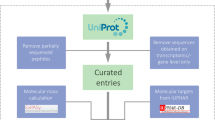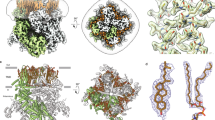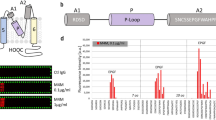Abstract
Here we describe a strategy for generating ion-channel inhibitors. It takes advantage of antibody specificity combined with a pattern recognition approach that targets the third extracellular region (E3) of a channel. To test the concept, we first focused on TRPC5, a member of the transient receptor potential (TRP) calcium channel family, the study of which has been hindered by poor pharmacological tools. Extracellular application of E3-targeted anti-TRPC5 antibody led to a specific TRPC5 inhibitor, enabling TRPC5 to be distinguished from its closest family members, and TRPC5 function to be explored in a relatively intractable physiological system. E3 targeting was further applied to voltage-gated sodium channels, leading to discovery of a subtype-specific inhibitor of NaV1.5. These examples illustrate the potential power of E3 targeting as a systematic method for producing gene-type specific ion-channel inhibitors for use in routine assays on cells or tissues from a range of species and having therapeutic potential.
This is a preview of subscription content, access via your institution
Access options
Subscribe to this journal
Receive 12 print issues and online access
$209.00 per year
only $17.42 per issue
Buy this article
- Purchase on Springer Link
- Instant access to full article PDF
Prices may be subject to local taxes which are calculated during checkout




Similar content being viewed by others
References
Lander, E.S. et al. Initial sequencing and analysis of the human genome. Nature 409, 860–921 (2001).
Waterston, R.H. et al. Initial sequencing and comparative analysis of the mouse genome. Nature 420, 520–562 (2002).
Tamm, I., Dorken, B. & Hartmann, G. Antisense therapy in oncology: new hope for an old idea? Lancet 358, 489–497 (2001).
Mak, T.W., Penninger, J.M. & Ohashi, P.S. Knockout mice: a paradigm shift in modern immunology. Nat. Rev. Immunol. 1, 11–19 (2001).
Reynolds, A. et al. Rational siRNA design for RNA interference. Nat. Biotechnol. 22, 326–330 (2004).
Zan, Y. et al. Production of knockout rats using ENU mutagenesis and a yeast-based screening assay. Nat. Biotechnol. 21, 645–651 (2003).
Bridge, A.J., Pebernard, S., Ducraux, A., Nicoulaz, A.L. & Iggo, R. Induction of an interferon response by RNAi vectors in mammalian cells. Nat. Genet. 34, 263–264 (2003).
Vennekamp, J. et al. Kv1.3-blocking 5-phenylalkoxypsoralens: a new class of immunomodulators. Mol. Pharmacol. 65, 1364–1374 (2004).
Kaczorowski, G.J., Knaus, H.G., Leonard, R.J., McManus, O.B. & Garcia, M.L. High-conductance calcium-activated potassium channels; structure, pharmacology, and function. J. Bioenerg. Biomembr. 28, 255–267 (1996).
Li, R.A. & Tomaselli, G.F. Using the deadly mu-conotoxins as probes of voltage-gated sodium channels. Toxicon 44, 117–122 (2004).
Triggle, D.J. Drug targets in the voltage-gated calcium channel family: why some are and some are not. Assay Drug Dev. Technol. 1, 719–733 (2003).
Mohler, P.J. et al. Nav1.5 E1053K mutation causing Brugada syndrome blocks binding to ankyrin-G and expression of Nav1.5 on the surface of cardiomyocytes. Proc. Natl. Acad. Sci. USA 101, 17533–17538 (2004).
Ong, A.C. & Wheatley, D.N. Polycystic kidney disease–the ciliary connection. Lancet 361, 774–776 (2003).
Rogawski, M.A. KCNQ2/KCNQ3 K+ channels and the molecular pathogenesis of epilepsy: implications for therapy. Trends Neurosci. 23, 393–398 (2000).
Tsavaler, L., Shapero, M.H., Morkowski, S. & Laus, R. Trp-p8, a novel prostate-specific gene, is up-regulated in prostate cancer and other malignancies and shares high homology with transient receptor potential calcium channel proteins. Cancer Res. 61, 3760–3769 (2001).
Vandenberg, J.I., Walker, B.D. & Campbell, T.J. HERG K+ channels: friend and foe. Trends Pharmacol. Sci. 22, 240–246 (2001).
Wehrens, X.H. et al. A novel mutation L619F in the cardiac Na+ channel SCN5A associated with long-QT syndrome (LQT3): a role for the I–II linker in inactivation gating. Hum. Mutat. 21, 552 (2003).
Wood, J.N., Boorman, J.P., Okuse, K. & Baker, M.D. Voltage-gated sodium channels and pain pathways. J. Neurobiol. 61, 55–71 (2004).
Utku, N. et al. Prevention of acute allograft rejection by antibody targeting of TIRC7, a novel T cell membrane protein. Immunity 9, 509–518 (1998).
Dumoulin, M. et al. A camelid antibody fragment inhibits the formation of amyloid fibrils by human lysozyme. Nature 424, 783–788 (2003).
Harris, M. Monoclonal antibodies as therapeutic agents for cancer. Lancet Oncol. 5, 292–302 (2004).
Wei, X. et al. Antibody neutralization and escape by HIV-1. Nature 422, 307–312 (2003).
Roque, A.C., Lowe, C.R. & Taipa, M.A. Antibodies and genetically engineered related molecules: production and purification. Biotechnol. Prog. 20, 639–654 (2004).
Sanz, L., Blanco, B. & Alvarez-Vallina, L. Antibodies and gene therapy: teaching old 'magic bullets' new tricks. Trends Immunol. 25, 85–91 (2004).
Clapham, D.E. TRP channels as cellular sensors. Nature 426, 517–524 (2003).
Greka, A., Navarro, B., Oancea, E., Duggan, A. & Clapham, D.E. TRPC5 is a regulator of hippocampal neurite length and growth cone morphology. Nat. Neurosci. 6, 837–845 (2003).
Zeng, F. et al. Human TRPC5 channel activated by a multiplicity of signals in a single cell. J. Physiol. (Lond.) 559, 739–750 (2004).
Schaefer, M. et al. Receptor-mediated regulation of the nonselective cation channels TRPC4 and TRPC5. J. Biol. Chem. 275, 17517–17526 (2000).
Flemming, R., Cheong, A., Dedman, A.M. & Beech, D.J. Discrete store-operated calcium influx into an intracellular compartment in rabbit arteriolar smooth muscle. J. Physiol. (Lond.) 543, 455–464 (2002).
Flemming, R., Xu, S.Z. & Beech, D.J. Pharmacological profile of store-operated channels in cerebral arteriolar smooth muscle cells. Br. J. Pharmacol. 139, 955–965 (2003).
Catterall, W.A., Goldin, A.L. & Waxman, S.G. International Union of Pharmacology. XXXIX. Compendium of voltage-gated ion channels: sodium channels. Pharmacol. Rev. 55, 575–578 (2003).
Alexander, S.P., Mathie, A. & Peters, J.A. Guide to receptors and channels, 1st edition. Br. J. Pharmacol. 141 suppl. Suppl. 1, S1–126 (2004).
Meiri, H., Sammar, M. & Schwartz, A. Production and use of synthetic peptide antibodies to map region associated with sodium channel inactivation. Methods Enzymol. 178, 714–739 (1989).
Wyatt, C.N. et al. Voltage-dependent binding and calcium channel current inhibition by an anti-alpha 1D subunit antibody in rat dorsal root ganglion neurones and guinea-pig myocytes. J. Physiol. (Lond.) 502, 307–319 (1997).
Ferrara, N., Hillan, K.J., Gerber, H.P. & Novotny, W. Discovery and development of bevacizumab, an anti-VEGF antibody for treating cancer. Nat. Rev. Drug Discov. 3, 391–400 (2004).
Salfeld, J.G. Use of new biotechnology to design rational drugs against newly defined targets. Best Pract. Res. Clin. Rheumatol. 18, 81–95 (2004).
Grunwald, V. & Hidalgo, M. Developing inhibitors of the epidermal growth factor receptor for cancer treatment. J. Natl. Cancer Inst. 95, 851–867 (2003).
Xu, S.Z. & Beech, D.J. TrpC1 is a membrane-spanning subunit of store-operated Ca2+ channels in native vascular smooth muscle cells. Circ. Res. 88, 84–87 (2001).
Zhou, B.Y., Ma, W. & Huang, X.Y. Specific antibodies to the external vestibule of voltage-gated potassium channels block current. J. Gen. Physiol. 111, 555–563 (1998).
Rosado, J.A., Brownlow, S.L. & Sage, S.O. Endogenously expressed Trp1 is involved in store-mediated Ca2+ entry by conformational coupling in human platelets. J. Biol. Chem. 277, 42157–42163 (2002).
Ahmmed, G.U. et al. Protein kinase Calpha phosphorylates the TRPC1 channel and regulates store-operated Ca2+ entry in endothelial cells. J. Biol. Chem. 279, 20941–20949 (2004).
Acknowledgements
We are grateful to C. Montell, J. Putney, Y. Mori, A. Srivastava and T. Zimmer for TRPC1, TRPC4, TRPC5, NaV1.4/5 cDNAs, and A.N. Bateson and J. Colyer for critical reading of the manuscript. The work was supported by the Wellcome Trust and British Heart Foundation.
Author information
Authors and Affiliations
Corresponding author
Ethics declarations
Competing interests
The authors declare no competing financial interests.
Rights and permissions
About this article
Cite this article
Xu, SZ., Zeng, F., Lei, M. et al. Generation of functional ion-channel tools by E3 targeting. Nat Biotechnol 23, 1289–1293 (2005). https://doi.org/10.1038/nbt1148
Received:
Accepted:
Published:
Issue Date:
DOI: https://doi.org/10.1038/nbt1148
This article is cited by
-
Challenges in the development of novel therapies, vaccines and siRNAs for the treatment of hypertension
Hypertension Research (2023)
-
Therapeutic vaccine for chronic diseases after the COVID-19 Era
Hypertension Research (2021)
-
TRPM4-specific blocking antibody attenuates reperfusion injury in a rat model of stroke
Pflügers Archiv - European Journal of Physiology (2019)
-
TRPC5 channels participate in pressure-sensing in aortic baroreceptors
Nature Communications (2016)
-
Transient receptor potential canonical 4 and 5 proteins as targets in cancer therapeutics
European Biophysics Journal (2016)



